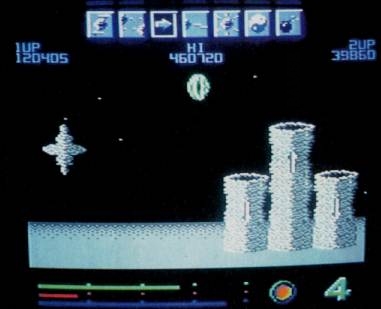Now, as we all know – Wizball got a release and was one of the best games ever to grace the C64. It’s a fantastic title which you should check out if you haven’t already.

However, German magazine "Happy Computer" previewed what was a rather different looking game in their March 1987 issue. The Dashboard in particular is very different, as are the game graphics. Only the score panel and main sprite look familiar.
Thanks to Slator, we learn that the screenshot was taken from the article about Ocean software – part of a special report called "Soft story" and was not part of the normal game testing/previewing but about a visit at Ocean/Imagine in Manchester, where they showed the latest stuff to the magazine guys.
Andreas Wanda also kindly sheds some light on what the article was about:
"The article is an interview with Ocean operations director Colin Stokes, who has to field some deft questions from Heinrich Lenhardt in the beginning on why Ocean hit new lows with the recent trilogy of disasters "Knight Rider", "Miami Vice" and "It’s a Knockout". Stokes explains that they had essentially lost control over their freelance developers, who handed over their sub-par product when Ocean had already booked ad space and stores had already been taking orders. Ocean thus bit the bullet and released these titles to honour their contractual obligations. The forbidding expenses for these massacred licenses and, most importantly, the substantial loss of customer acceptance subsequently made Ocean do a 180 to focus on internal development again.
To prove his point, Colin Stokes shows off several triple-A releases being prepped for release, such as the "Short Circuit" tie in, "Super Soccer" and the arcade conversion "Arkanoid". Stokes elaborates on the latter, noting how much easier it has become for their in-house developers to convert arcade games because the original hardware can be fitted into a suitcase with a joystick port, allowing them to check on the real deal virtually whenever and wherever they like.
In between, Stokes touches upon a mysterious new release: "’Wizzball’ is the brand-new project by the ‘Parallax’-team. While the game is only in a very early stage of development, part of the graphics have already been completed: the player controls some kind of watermelon which hops and blasts across the screen. The scrolling is excellent." That is all this article has to say about the upcoming "Wizzball"."
Source for the scans can be found here, but you can also check out the scans here:
Magazine scan page 1
Magazine scan page 2
It is of great thanks to the guys at www.kultpower.de who have made finding the scans possible and are a fantastic resource for German magazines and the retro world!
We doubt that nothing will be found of the preview, but here it is for posterity. Just how different was the game itself?…. Was it just the graphics which were heavily tweaked, or are there gameplay elements which were taken out for the final game.
Interestingly, Slator believes that the mis-spell must have been made at this stage and it stuck in the minds of Ocean up until the mastering where the tape got stuck with "Wizzball".
Do you know any more about this earlier version?

